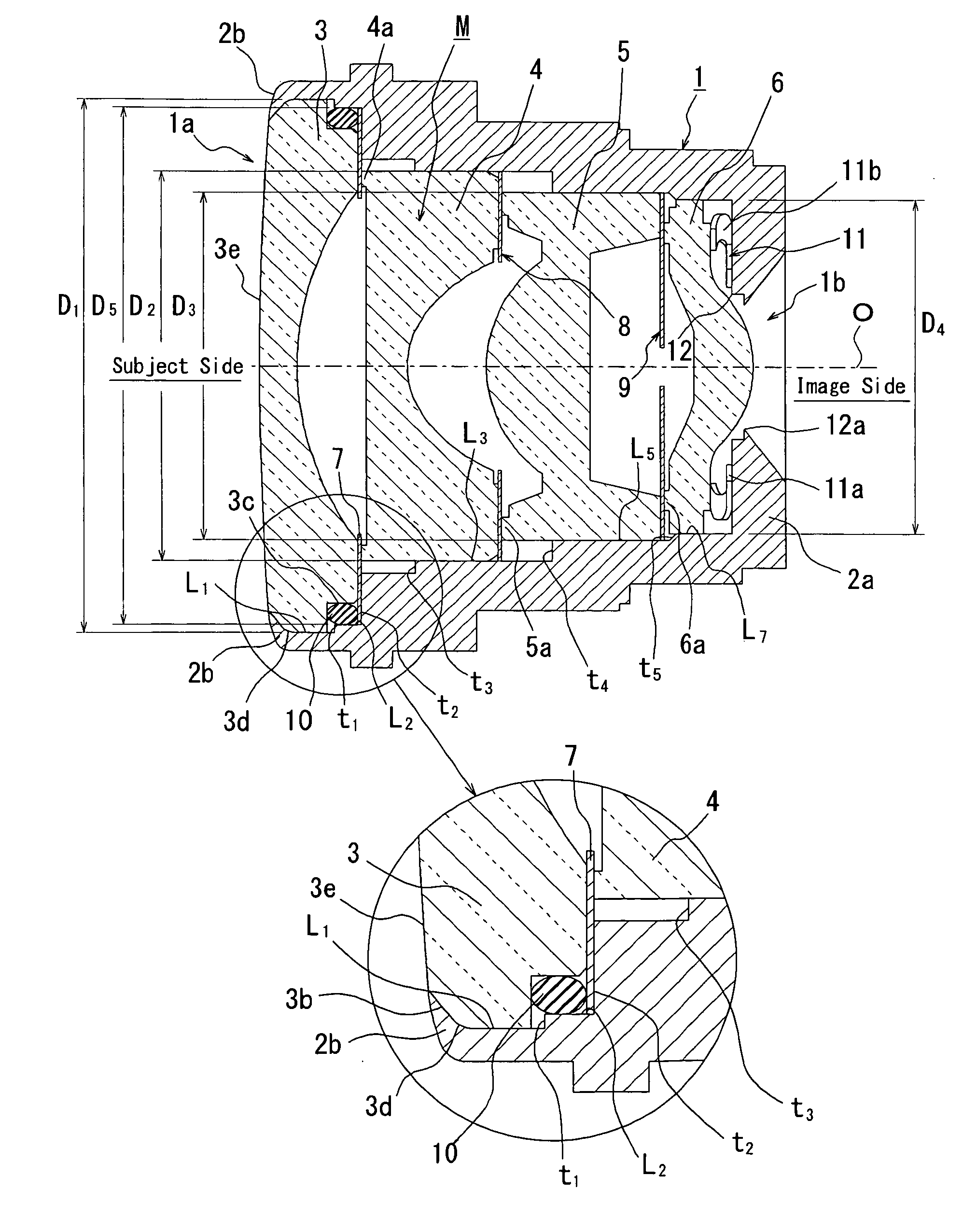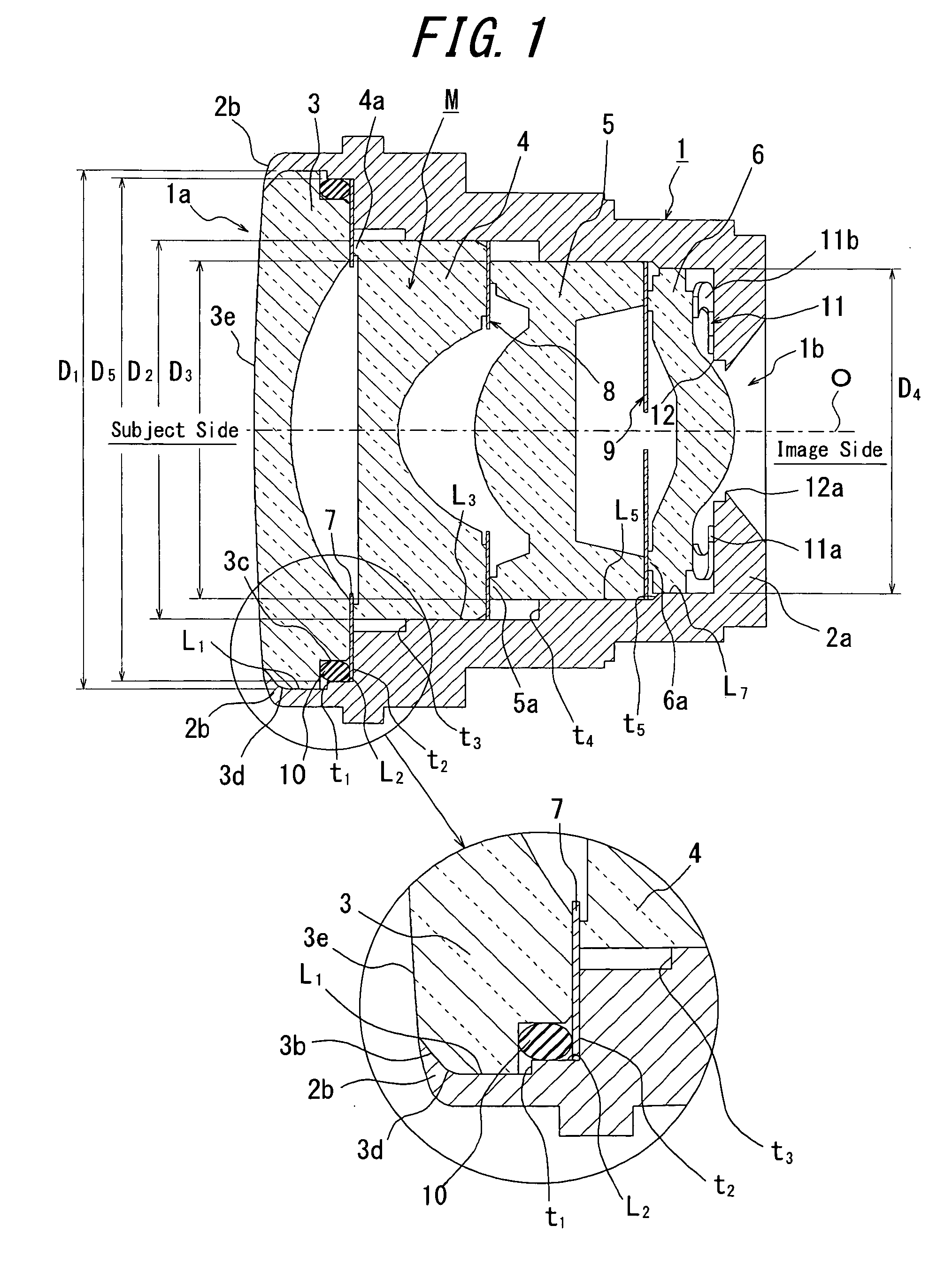Lens assembly
- Summary
- Abstract
- Description
- Claims
- Application Information
AI Technical Summary
Benefits of technology
Problems solved by technology
Method used
Image
Examples
first embodiment
The First Embodiment
[0047]FIG. 1 is a cross sectional view schematically illustrating of a lens assembly according to an embodiment of the present invention and FIG. 2 is an exploded perspective view of FIG. 1.
[0048]As shown in FIGS. 1 and 2, the lens assembly of the present embodiment retains a lens group M comprising four lenses; the first lens 3, the second lens 4, the third lens 5, and the fourth lens 6, on a lens frame 1 along the optical axis O. In the present description, the side of the first lens 3 will be called the subject side (the left had side in the document sheet) and the side of the fourth lens 6 will be called the image side (the right hand side in the document sheet) hereinafter, for convenience. The subject side and the image side of each lens may respectively be called front side and back side.
[0049]The lens frame 1 comprises a circumferential wall of plastics or metal material, and has the subject side aperture 1a and the image side aperture 1b, each opens to b...
second embodiment
The Second Embodiment
[0067]FIG. 5 is a cross sectional view schematically showing the lens assembly according to a second embodiment of the present invention, and FIG. 6 is an appearance perspective view showing an exploded state of the lens assembly as shown in FIG. 5
[0068]As shown in FIGS. 5 and 6, the lens assembly 1 according to the present embodiment is substantially the same as the lens assembly according to the first embodiment, except that the curvature of the lens face on the subject side of the first lens 3 is infinite, i.e. the lens face is flat, and the first lens 3 is supported at the chamfer 3b formed at the flat lens surface thereof by the entire circumference support 2b such that the entire circumference support 2b is continuous with the flat lens surface.
[0069]When the lens surface is flat, the chamfer is formed in the lens at an angle of approximately 45 degrees with respect to the flat lens surface, in a manner similar to the normal chamfering process, so as to su...
third embodiment
The Third Embodiment
[0072]FIG. 7 is a cross sectional view schematically showing a structure of the lens assembly according to a third embodiment of the present invention, and FIG. 8 is an exploded perspective view thereof.
[0073]As shown in FIGS. 7 and 8, the lens assembly of the present embodiment comprises a lens group M, the lens frame 1, the first lens 3, the flare diaphragms 7 and 8, the aperture diaphragm 9, and the elastic member 11, which are configured similarly to those in the first embodiment.
[0074]The lens assembly of the present embodiment is basically the same as the lens assembly 1 of the first embodiment, except that the shapes of the outer circumferential surfaces of the second lens 4 and the third lens 5 and the shape of the inner peripheral portion of the lens frame 1 contacting thereto have bee modified.
[0075]Because of this, in the present embodiment, the second lens 4 is formed by the concave meniscus lens made of plastics, the equi-diameter outer circumferenti...
PUM
 Login to View More
Login to View More Abstract
Description
Claims
Application Information
 Login to View More
Login to View More - R&D
- Intellectual Property
- Life Sciences
- Materials
- Tech Scout
- Unparalleled Data Quality
- Higher Quality Content
- 60% Fewer Hallucinations
Browse by: Latest US Patents, China's latest patents, Technical Efficacy Thesaurus, Application Domain, Technology Topic, Popular Technical Reports.
© 2025 PatSnap. All rights reserved.Legal|Privacy policy|Modern Slavery Act Transparency Statement|Sitemap|About US| Contact US: help@patsnap.com



